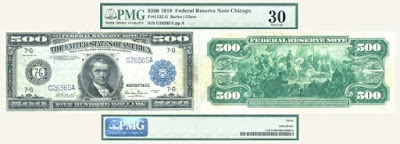In December of 1913, during his first year in office, Democratic President Woodrow Wilson aggressively influenced and subsequently signed into law the Federal Reserve Act. This Act of Congress established the Federal Reserve System and the US Central Banking System (a major reform for US banking and currency).
Importantly, this Act provided the US central banking system official authority to issue Federal Reserve Notes and Federal Reserve Bank Notes as legally authorized US currency. Strong critics to this day (most especially conservative Republicans) question whether the Federal Government has the constitutional authority to create such sweeping reform. Does this Act (and the Federal Reserve System) protect powerful financial interests and thereby increase recession risks such as what this nation has just experienced? Notably, the bill’s co-sponsor was the Chairmen of the House Banking and Currency Committee, Virginia Congressional Democratic Representative Carter Glass.
Though WWI (the Great War, The War to End all Wars) began in Europe in 1914, America did not officially enter this war until 6 April 1917. Democratic President Woodrow Wilson (our 28th president who served from 1913 to 1921) promised to “keep us out of war” as his running campaign and this promise helped him win the 1913 election. WW1 ended on 11 November 1918 – Armistice Day -- a day we continue recognize and honor the more than 50,000 soldiers who perished during this Great War.
Wilson won presidential election in 1913 due in part to his vow for neutrality, Wilson and Glass helped establish the banking and currency reform that made this series 1918 Federal Reserve Note possible. Both men were from Virginia, both were Democrats, and both advocated for the federal authority behind sweeping banking reform. Carter Glass served as the US Secretary of the Treasury, appointed by President Wilson, from 1918 to 1920 – a very short period of time.
His signature as Secretary of the Treasury is seen on series 1914 and 1918 Federal Reserve Notes, printed while he held that position.
So that explains the Carter Glass signature, but who was John Burke and why is the Burke-Glass signature combination so rare?
The note’s central portrait figure is that of US Supreme Court Chief Justice John Marshall who lived from 1755 to 1835 and served as the fourth US Chief Justice from 1801-1835. Marshall remains the court’s longest serving Chief Justice. Of huge importance were Marshall’s efforts to establish the US Supreme Court as an equal and independent third government branch, along with the executive and legislative branches.
Like Wilson and Glass, Marshall was also a Virginian and like Wilson and Glass, worked to build a strong federal government For example, the 1819 US Supreme Court decision in the McCulloch v. Maryland case upheld the power of the federal government to authorize the Second Bank of the United States.
© 2016. Treasuredstocks.com
For more information about and examples of Federal Reserve Notes and other rare currency, please visit treasuredstocks.com. For queries and questions, please call me, Jeff Smith, at 870-670-4255 or email me jeff@treasuredstocks.com
We are official members of multiple numismatic-related organizations. Thus, Treasuredstocks.com welcomes any and all questions regarding our coin and currency postings and our passion for collecting coins and currency of all types.


No comments:
Post a Comment